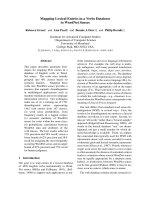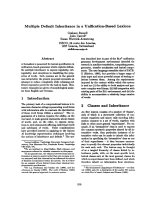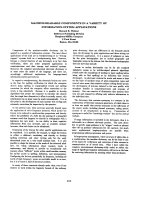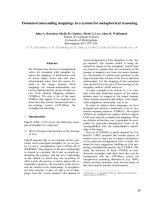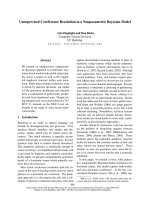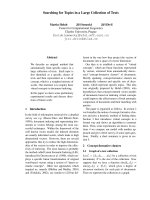báo cáo khoa học: "Congenital spinal tumor in a patient with encephalocele and hydrocephalus: a case report" doc
Bạn đang xem bản rút gọn của tài liệu. Xem và tải ngay bản đầy đủ của tài liệu tại đây (1.75 MB, 4 trang )
CAS E REP O R T Open Access
Congenital spinal tumor in a patient with
encephalocele and hydrocephalus: a case report
Farid Radmanesh
1
, Farideh Nejat
1*
, Fatemeh Mahjoub
2
, Mostafa El Khashab
3
Abstract
Introduction: Encephalocele is a rare congenital abnormality of the central nervous system, where brain tissue
protrudes from a defect in the skull. Some anomalies are associated with encephalocele. However, the association
of spinal teratoma and encephalocele has not been reported in the English literature.
Case presentation: We report the case of an Iranian girl with a history of encephalocele surgery, who, at the age
of four years, developed an intramedullary spinal teratoma, and discuss the pathogenesis of this association.
Conclusion: To the best of our knowledge , this is the first report of an association between encephalocele and
spinal teratoma.
Introduction
Encephalocele refers to a group of rare congenital
anomalies of the central nervous system (CNS), where
brain tissue protrudes from a defect in the skull [1]. Its
prevalence has been estimated to be 0.8 to four in ev ery
10,000 live births [2].
Teratomas are tumors derived from all three germ
layers [3]. In children, teratomas are more commonly
found in the sacroc occygeal region than in the spinal
cord [4], which o ccurs in one of 38,500 viable births.
Intramedullary spinal teratomas are rare tumors [5]. In
41.7% of teratomas, a concomitant anomaly of the ver-
tebral canal is found, most commonly a diastematomye-
lia, [4]. However to the best of our knowledge, there is
nor repot of an association with en cephalocele in the
English literature.
We report a case of encephalocele and lumbar intra-
medullary teratoma and discuss the possible etiology.
Case presentation
A four-year old Iranian girl was referred to the neurosurgi-
cal department with severe back pain and motor regres-
sion. She was the second child of nonconsanguineous
parents, and was delivered by elective Cesarean section
due to being repeat. She had a history of occipital
encephalocele, which was treated surgically during the
neonatal period and she later received a shunt to treat pro-
gressive hydrocephalus. She could sit at nine month of age
and stand at two years, but was unable to walk. Six
months before her referral, she had developed back pain,
which was particularly severe at night, and after three
months, she was unable to stand.
On physical examination, our patient was found to be
generally normal, with good mental performance, and
normal results f rom a neurologic al examination of the
arms. She had a head circumference on the 75th percen-
tile and a functional ventriculoperitoneal shunt. She
could move her legs, but was u nable to keep them up
against gravity. Her deep tendon reflexes in the legs
were exaggerated, and her sensory level was undetect-
able. She had urinary and fecal incontinence.
Spinal MRI revealed an intradural mass (Figure 1,
Figure 2) extending from the T11 to T12 junction to
the lower border of L2 vertebra. It was isointense on
T1- and T2-weighted images, with a small piece of tis-
sue on the dorsa of the mass, which was identified as
lipoma.
The child underwent an osteoplastic laminotomy
extending from T11 to L2. The dura matter was severely
tenseatthelevelwherethelaminotomywasopened.
There was a white to creamy mass that was extramedul-
lary at the distal level but intramedullary at the L1 and
T12 levels. There was no real capsule around the mass,
which contained small fine hairs and creamy fatty material.
* Correspondence:
1
Department of Neurosurgery, Children’s Hospital Medical Center, Tehran
University of Medical Science, Tehran, Iran
Full list of author information is available at the end of the article
Radmanesh et al. Journal of Medical Case Reports 2011, 5:9
/>JOURNAL OF MEDICAL
CASE REPORTS
© 2011 Radmanesh et al; licensee BioMed Central Ltd. This is an Open Access article distributed under the terms of the Creative
Commons Attributio n License (http://creativecomm ons.org/licenses/by/2.0), which permits unrestricted us e, distribution, and
reproduction in any medium, provided the original work is pro perly cited.
Figure 1 Sagittal T1-weighted MRI scan showing an isointense tumor with fat signal on the dorsal surface.
Figure 2 Sagittal T2-weighted MRI scan showing an isointense mass in the thoracolumbar area.
Radmanesh et al. Journal of Medical Case Reports 2011, 5:9
/>Page 2 of 4
Therewasasmalllipomaonthedorsalsurfaceofthe
mass at the level of the L1 spine body.
The lesion was excised completely. Histopathologic
examination of the mass revealed a variety of tissues
including skin, fat, connective and adipose tissue, and
vascular structures (Figure 3). A pathological diagnosis
of mature teratoma was made.
Our patient’s post-ope rative period was unremarkable.
One year after the operation she was able to stand by
herself and to walk with the aid of a brace and walker.
She was continent during the day but had nocturia.
Discussion
Encephalocele is a cystic congenital malformation in
which the cranial con tents herniate through a defect in
the cranium. Although encephalocele is typically classi-
fied as a neural tube defect, its underlying mechanism
may differ from that of myelomeningocele, and pro bably
occurs after neural tube closure [1]. Encephaloceles may
present alone or in association with other congenital
nervous system anomalies [1]. The presence of an intra-
medullary teratoma in ass ociation with encephalocele
has not been reported previously.
Teratomas are tumors composed of derivatives of all
three germ cell layers, and can be classified into mature
and immature types based on the degree of differentia-
tion [3]. The overall frequency of teratoma is o ne in
13,000 [3]. The origin of teratomas of the spina l cord is
controversial. There are various theories on the patho-
genesis of teratomas. The traditional view is t hat
intraspinal teratomas arise from primordial germ cell
misplaced from the primi tive yolk sac, most commonly
into midline structures [5]. In a more recent review of
literature, Koen et al. suggested that a dysembryogenic
process forms the basis of development of teratoma,
especially those arising from spinal dysraphism. They
proposed that the combination of mutated genes impor-
tant for normal early neural development and cellular
differentiation, and/or absent or deficient inductive
signals, can lead to the formation of teratoma [6].
Figure 3 Variety of tissues including skin, fat, connective and adipose tissue, and vascular structures (haematoxylin and eosin, original
magnification × 40).
Radmanesh et al. Journal of Medical Case Reports 2011, 5:9
/>Page 3 of 4
Moreover, the abnormal genetic and molecular pathways
that result in the formation of encephalocele remain
unclear. Although the possib ility of two different patho-
genesis cannot be excluded, it is more likely that the
same genetic and molecular defects are responsible for
this spectrum of findings. It is possible that these
defects, which are present throughout t he neuraxis,
result in these two congenital anomalies, although they
are theoretically formed during different stages of devel-
opment. Because teratoma causes symptoms mainly
through its mass effect as a resu lt of progressive growth,
there is a delay in symptoms becoming apparent.
This case emphasizes that, when dealing with a patient
with a congenital anomaly who presents with new signs
and symptoms or loss of developmental abilities that
had already been acquired, it is essential to investigate if
the new symptoms are due to causes other than the
already ex isting anomaly, as in our patient. It is possible
that another anomaly may b e causing the symptoms,
and the necessary investigations should be performed.
Conclusion
In any patient with a congenital central nervous system
anomaly who presents with new neurologic problems,
the po ssibility of another anomaly, especially those that
are believed to arise from the same pathogenic pathway,
should be considered.
The exact pathogenic pathway of association b etween
encephaloc ele and spinal teratomas remains to be eluci-
dated. Although the possibility of two different patho-
geneses could not be ruled out in our patient, it is more
likely that t he same genetic and molecular defects are
responsible for this spectrum of findings. Further studies
are needed to elucidate the probable genetic and mole-
cular defects underlying these conditions.
Consent
Written informed consent was obtained from the par-
ents of the patient for publication of this case report
and any accompanying images. A copy of the written
consent is available for review by the Editor-in-Chief of
this journal.
Author details
1
Department of Neurosurgery, Children’s Hospital Medical Center, Tehran
University of Medical Science, Tehran, Iran.
2
Department of Pathology, Imam
Khomeini Hospital, Tehran University of Medical Sciences, Tehran, Iran.
3
Department of Neurosurgery, Hackensack University Medical Center,
New Jersey, USA.
Authors’ contributions
FR and FN made major contributions in patient care, literature review and
drafting of the manuscript. MEK made a substantial contribution to the
literature review, correction and final approval of the manuscript. FM made
the pathological exam and description. All authors read and approved the
final manuscript.
Competing interests
The authors declare that they have no competing interests.
Received: 28 October 2008 Accepted: 14 January 2011
Published: 14 January 2011
References
1. Rowland CA, Correa A, Cragan JD, Alverson CJ: Are Encephaloceles Neural
tube defects? Pediatrics 2006, 118:916-923.
2. Radmanesh F, Nejat F, Monajemzadeh M: Teratoma within an
encephalocele: common etiology or coincidence? J Neurosurg 2007,
107:263-265.
3. Bosma JJD, Malluci CL, May PL: Thoracolumbar teratoma associated with
meningomyelocele: common aetiology or coincidence? Child’s Nerv Sys
2002, 18:299-301.
4. Poeze M, Herpers M, Tjandra B, Freling G, Beuls E: Intramedullary spinal
teratoma presenting with urinary retention: case report and review of
the literature. Neurosurg 1999, 45:379-393.
5. Guvenc BH, Etus V, Muezzinoglu B: Lumbar teratoma presenting
intradural and extramedullary extension in a neonate. Spine Jour 2006,
6:90-93.
6. Koen JL, Mclendon RE, George TM: Intradural spinal teratoma: evidence
for a dysembryonic origin. J Neurosurg 1998, 89:844-851.
doi:10.1186/1752-1947-5-9
Cite this article as: Radmanesh et al.: Congenital spinal tumor in a
patient with encephalocele and hydrocephalus: a case report. Journal of
Medical Case Reports 2011 5:9.
Submit your next manuscript to BioMed Central
and take full advantage of:
• Convenient online submission
• Thorough peer review
• No space constraints or color figure charges
• Immediate publication on acceptance
• Inclusion in PubMed, CAS, Scopus and Google Scholar
• Research which is freely available for redistribution
Submit your manuscript at
www.biomedcentral.com/submit
Radmanesh et al. Journal of Medical Case Reports 2011, 5:9
/>Page 4 of 4


